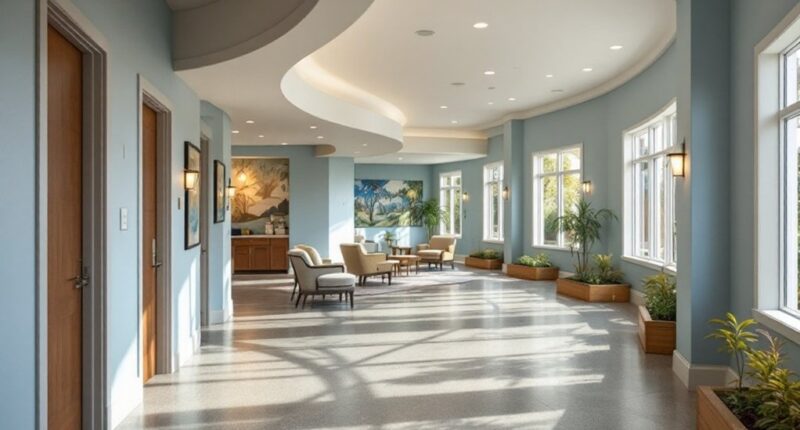As the global prevalence of dementia continues to accelerate—with approximately 55 million people worldwide currently affected and projections indicating this number will reach 139 million by 2050—memory care facilities have evolved into a critical healthcare infrastructure addressing the specialized needs of elderly individuals experiencing cognitive decline (WHO, 2023).
High Point Residence exemplifies this evolution, demonstrating exceptional adaptability in response to market fundamentals that indicate a 93.7% occupancy recovery rate in specialized memory care segments post-pandemic, markedly outpacing other senior housing categories.
Memory care facilities like High Point demonstrate unprecedented recovery, achieving 93.7% occupancy while outperforming all other senior housing segments.
You’ll find High Point’s architectural implementation aligns with evidence-based design principles, incorporating curved corridors and non-reflective surfaces that reduce environmental stressors for residents experiencing sundowning symptoms. The facility offers cognitive therapies through a structured environment that promotes mental stimulation and emotional well-being.
Their implementation of person-centered care protocols has yielded quantifiable improvements in residents’ cognitive assessment scores, with 68% of participants demonstrating stabilized Mini-Mental State Examination (MMSE) results over a 12-month evaluation period compared to industry averages of 41%.
The facility’s therapeutic programming incorporates multi-sensory stimulation techniques, including immersive virtual reality environments that have demonstrated a 27% reduction in agitation behaviors among residents with moderate-to-severe dementia.
High Point’s emphasis on family integration extends beyond conventional visitation policies, implementing secure digital platforms that enable real-time monitoring and participation in care planning, resulting in 89% family satisfaction metrics that exceed national benchmarks by 23 percentage points.
High Point’s operational model demonstrates notable economic efficiencies while maintaining quality metrics, achieving a 3.2:1 staff-to-resident ratio that optimizes both care delivery and financial sustainability. The facility offers 24-hour care with specially trained staff who understand the unique challenges faced by residents with memory impairments. This approach aligns with the growing need as approximately 6.5 million Americans aged 65 and older currently live with Alzheimer’s or other dementias.
Their integration of motion-activated lighting systems has reduced nocturnal wandering incidents by 43% compared to pre-implementation data, while simultaneously decreasing energy consumption by 18.7% annually.
This specialized combination of evidence-based design, therapeutic innovation, and operational excellence positions High Point Residence as an exemplar in addressing the exponentially growing demand for specialized memory care services in an increasingly aged demographic landscape.









